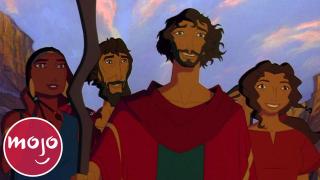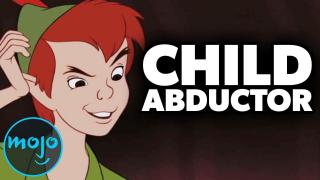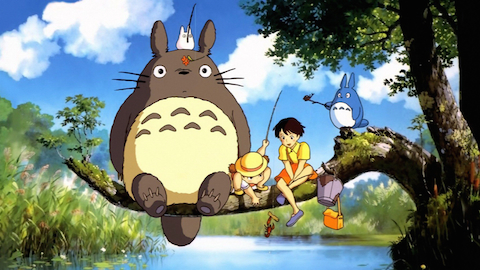Top 10 Awful Truths About Animated Movies We Love

#10: The Enchantress Curses a Child
Top 10 Friends Who Fall In Love In Animated Movies
“Beauty and the Beast” (1991)
In the prologue, we’re told that a prince is visited by a beggar, and after turning her away, has a gotcha moment when she reveals herself to be a witch, who then transforms him into a beast - and also curses his servants! To help him better himself - we guess? - she gives him an enchanted rose that will bloom until “his 21st year,” with the chance to break the spell if he can find reciprocal love. Okay, so the movie takes place 5 minutes after that, right? Nope. In “Be Our Guest,” Lumiere mentions this happened 10 years ago, which means the Beast was 11 when the Enchantress transformed him? Maybe we’re reading too much into this. But even in “The Enchanted Christmas,” he’s clearly a young child worried about stranger danger. Disney even tried to do away with how messed up that is by making him an adult in the 2017 version. Gaston the villain of “Beauty and the Beast”? Nu-uh, it’s the Enchantress.
#9: A Minor Gets His Kicks from Hurting Others
Top 10 Awful Truths About Movies We Love
“The Incredibles” (2004)
“The Incredibles” is a hilarious, heartfelt and thrilling film that grabs hold of the viewer’s attention and refuses to let go. It gets so much right, in fact, that it's easy to miss the film’s flaws. But one moment in the movie should definitely give the audiences pause. In their attempt to rescue Mr. Incredible, the family ends up on an island surrounded by henchmen with ultra-sophisticated weapons. Speedster Dash finds himself literally running for his life - and that’s good. What’s not so good is how several henchmen seemingly wind up dead during the pursuit - and Dash is apparently unfazed by it. We know it was a matter of life or death for Dash, but it’s off-putting seeing a 10-year-old getting pumped by this mayhem.
#8: Indigenous People Are Played for Laughs
“Peter Pan” (1953)
“Peter Pan” is a movie beloved by generations of fans, but it gets more and more problematic as years go by. Let’s forget for a moment that Peter himself is hardly the greatest role model; he’s arrogant, reckless - and arguably guilty of kidnapping! But the bigger problem with the film is its handling of indigenous people. The very title of the song they sing pretty much says it all. It’s made worse by the racist physical appearance of the characters and the stereotyped language and attitudes. “Peter Pan” might be a classic…but some scenes are downright hard to watch.
#7: You Probably Shouldn’t Take Food or Drink from Strangers
Top 10 Most Underappreciated Animated Movies
“Alice in Wonderland” (1951)
Parents who try to warn their kids about taking candy from a stranger - or eating or drinking any old thing that’s lying around - must hate this classic. Alice is constantly eating and drinking substances that make her grow taller or shrink her down. She jumps right in to have tea with a hatter who is clearly mad, and while there, she gets sugar smeared across her face in a manner that resembles a trail of cocaine. And that’s the bigger problem with Alice’s free and easy sampling of goodies: they take on a distinct tinge of drug use, altering her body and her mood in strange ways. Don’t believe us? Ask that hookah smoking caterpillar.
#6: The Stereotypes Are Jarring
Top 10 Awful Truths About Movie Characters We Love
“Dumbo” (1941)
Dumbo is just about as cute as a baby elephant can possibly be. However, this 1941 film is touching, amusing and at times quite racist. The circus workers are the only human Black characters in the film, and this depiction makes for an extremely dated and negative message. More problematic is the quintet of crows who show up to sing “When I See an Elephant Fly.” They speak in dialects and use language that is associated with racist history; the body language and mannerisms of the crows are similarly rooted in racist caricature. And actually naming one of them Jim Crow - well, you get the picture, even if Disney didn’t.
#5: Pleasure Island Is Too Harsh
Top 10 Guilty Pleasure Movies
“Pinocchio” (1940)
Disney’s second full-length animated film is a feast for the eyes, features a charming score, and is populated by numerous memorable characters. But some parts of it are rather dark, and the Pleasure Island sequence is downright nightmarish. In the film, dozens of young boys have been carted away to enjoy themselves away from parental restraint. They behave rather wildly -not surprising, given the circumstances- but they pay the price by being transformed into donkeys and sold away to live out their lives as pack animals. That sends a pretty harsh message about the value of little boys and how society views the worth of those who go astray.
#4: The Hyenas Are Portrayed in Racist Code
Top 10 Insanely Racist Moments in Animated Movies That You Forgot About
“The Lion King” (1994)
Although kings and queens are common fixtures in children’s stories, they rarely are placed in a real political or social context. It makes sense: the goings-on of court would bore the kids to tears. But there seems to be a distinct class system in place in “The Lion King,” with the royal family very much at the top - and the devious lowlife hyenas occupying the bottom rung. That might not be so bad if the hyenas weren’t presented in a manner that appears to code them as stereotyped Black and Latino “street thugs.” And with no other good or positive characters around who speak in the same way to provide contrast, it leaves a bad taste in one’s mouth.
#3: AND Scar Is Queer-Coded
Top 10 Animated Movies: 1980s
“The Lion King” (1994)
Wait, there’s more to face up to where “the Lion King” is concerned. Let’s talk about Scar. On the one hand, he’s a great villain - sly, treacherous, cunning, and absolutely ruthless. But he has something in common with a number of other Disney villains - some characteristics that subtly (or not so subtly) encourage the audience to view him as gay. Several critics have pointed out that Scar’s refined characteristics and voice can come across as stereotypically effeminate, he’s on the campy side and his paws are actually limp on occasion - possibly a nod to the derogatory term used to describe gay men “limp wristed.” There wouldn’t be anything wrong with a villain being gay if the film industry had a long history of featuring a wide range of LGBTQ+ characters. But with Hollywood only starting to expand in that area, the seemingly queer-coded Scar is one more movie character that leads to an association between these types of characteristics and villainous behavior.
#2: No One Is Siamese Like These
Top 10 Scariest Animated Movies That Will Send Chills Down Your Spine
“Lady and the Tramp” (1955)
The spaghetti scene in “Lady & the Tramp” is a favorite of loving couples everywhere. Less welcome, however, is the Asian stereotyping that comes with the arrival of Aunt Sarah’s Siamese cats. They may be feline, but they’ve been given features long associated with Asian racial typing, and their movements also reflect long-standing Asian caricatures. Worse, though, is their accent and their casting as malevolent, inscrutable villains. While feline Asian stereotyping would show up again in Disney’s “The Aristocats,” the larger and more impressive role played by Si and Am make them even harder to take.
Before we unveil our top pick, here are a few dishonorable mentions.
Ariel & Eric’s Relationship Is Based On… Nothing
“The Little Mermaid” (1989)
The Human Jessica Is Married to a Rabbit
“Who Framed Roger Rabbit?” (1988)
The Vigilante’s Crime Spree Goes Unpunished
“Batman: Mask of the Phantasm” (1993)
Tinkerbell Is Kind of a Psychopath
“Peter Pan” (1953)
#1: In Reality, She Was a Child
Top 20 Best Child Voice Acting Performances in Movies
“Pocahontas” (1995)
With the previous films, the awful truth had to do with things actually in them. With “Pocahontas,” the issue is what ISN’T put in the movie - reality. And since this musical romantic drama is based on history rather than pure fiction, that counts for a lot. The events and relationships throughout the film play fast and loose with the facts. But the biggest issue is simply that the real Native American woman with the nickname Pocahontas was not a woman at all, but a child of 10 or 11. John Smith, meanwhile was actually 28. Knowing the truth about their ages makes the love story extremely disturbing, and that’s putting it politely.










